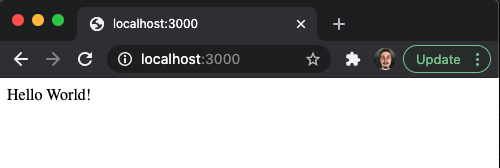Build a Node.js App page
Build a simple Express API to use for the rest of the course.
Overview
In this section, we are going to build a simple "Hello World" service using Express.
Node.js is not required if you just want to read through this section and copy/paste the code snippets. If you want to run the application natively before we containerize it in the next section, you can install Node.js here.
Building our app
The app requires only two files
package.jsonsrc/index.js
package.json
✏️ Create package.json in the root of your repository.
{
"name": "bitovi-academy-app",
"version": "1.0.0",
"scripts": {
"start": "nodemon src/index.js",
"start:prod": "node src/index.js"
},
"dependencies": {
"express": "^4.17.1"
},
"devDependencies": {
"nodemon": "^2.0.6"
}
}
This file defines express as a standard dependency and nodemon as a dev dependency. Nodemon is used to run our Express server and watches the source code to hot-reload any new changes without needing to restart the server. It is a dev dependency because we don’t want the overhead of running nodemon in production or even the bulk of keeping it in node_modules/.
Our package.json also defines a start script and a start:prod. These are convenient ways to allow us to start our application with nodemon or node by running npm start or npm run start:prod.
src/index.js
✏️ Create a src directory and index.js within it.
const express = require('express')
const app = express()
const port = process.env.PORT || 3000
app.get('/', (req, res) => {
res.send('Hello World!')
})
app.listen(port, () => {
console.log(`Example app listening at http://localhost:${port}`)
})
This file starts an express server listening on localhost:3000. If we access the root path it should return Hello World!. The default port is 3000, but can be overwritten by setting the PORT environment variable before starting the server.
Run our app
✏️ This step is optional, but to verify our app works you can run:
npm install
npm start
Open your browser to localhost:3000 and you should see Hello World!

What’s next
Now that we’ve created a simple Node.js app, we are going to containerize it.